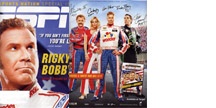
... and happy 2007! Many of you won't return to teaching/researching for a week or so, but I'm in intersession here at Ole Miss and we started bright and early, 8 a.m. on January 2. So it's time to get the blog cranked back up again.
The second issue of JSM is officially in design and layout, but I received several questions over the holidays (including one on Christmas Eve) related to appropriate material for the journal. If you're considering contributing please keep the following in mind--
1. The paper should primarily focus on media. Any area of sport is acceptable (economics, law, public relations, etc.) and any media (TV, radio, Internet, etc.), but the paper has to be an examination primarily grounded in the media. We often receive papers in which the media in the secondary or tertiary part of the research, and those are not a good fit for JSM. For example, how women have a difficult time working in professional sports media is a primary focus. Examing gender theory by applying it to women in sports media would be more secondary (the latter paper would fit better with the Journal of Sport and Social Issues).
2. It should have practical implications for sports media practitioners. One of the things we're trying to do with JSM is to give it practical value for editors, news directors, PR managers and the like. Ideally, the results of the research should go beyond mere theoretical value. I suppose it would be possible to do a study on the dress and attire of local TV sportscasters, but does anyone really care?
3. Please keep in mind our publishing schedule. As an annual, we publish only in the spring. So if you submit a paper to us today it won't get reviewed until July, an editorial decision won't be made until September and if accepted, it won't be published until 2008. We certainly hope to publish more frequently than once a year, but for now that's our schedule.
If you have any other questions, please feel free to ask at
bschultz@olemiss.edu. Have a great 2007 ...






